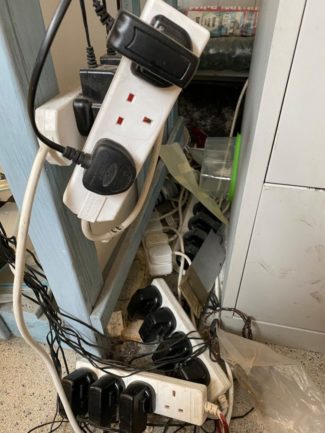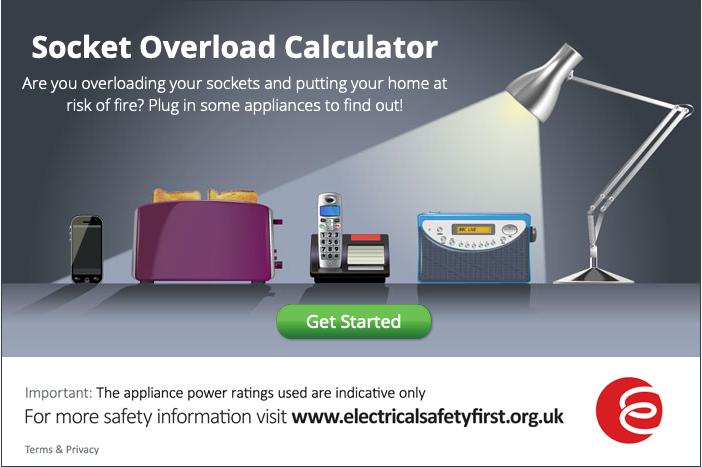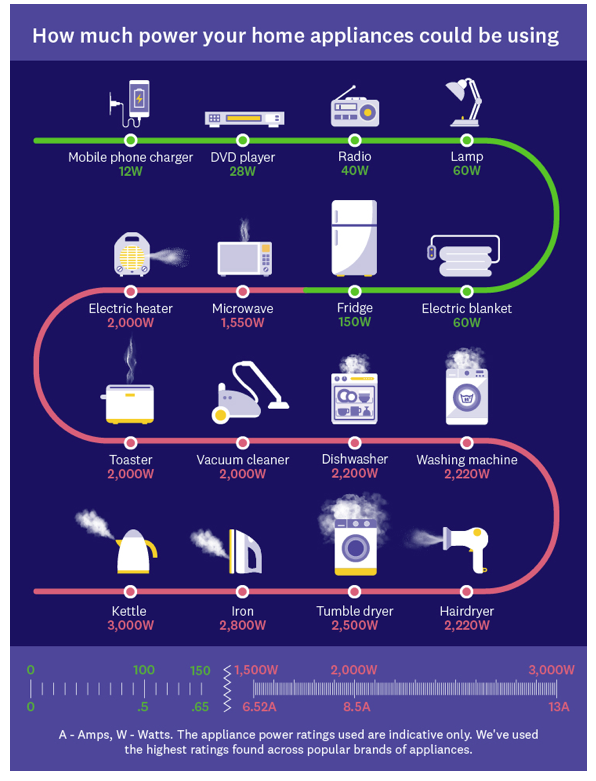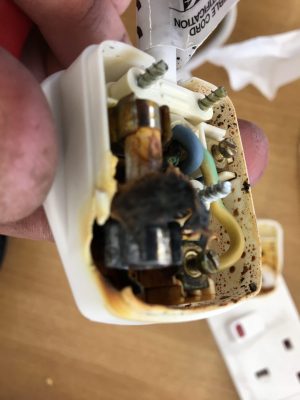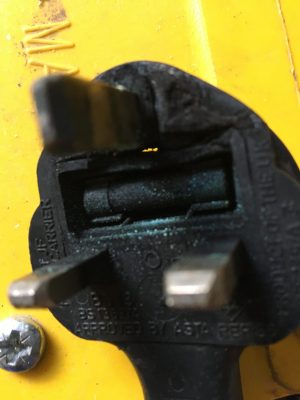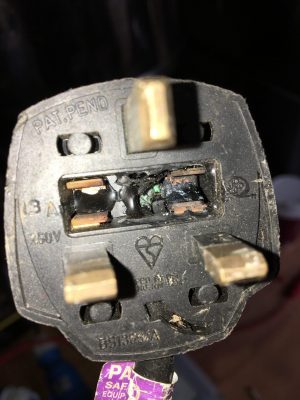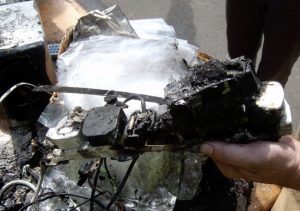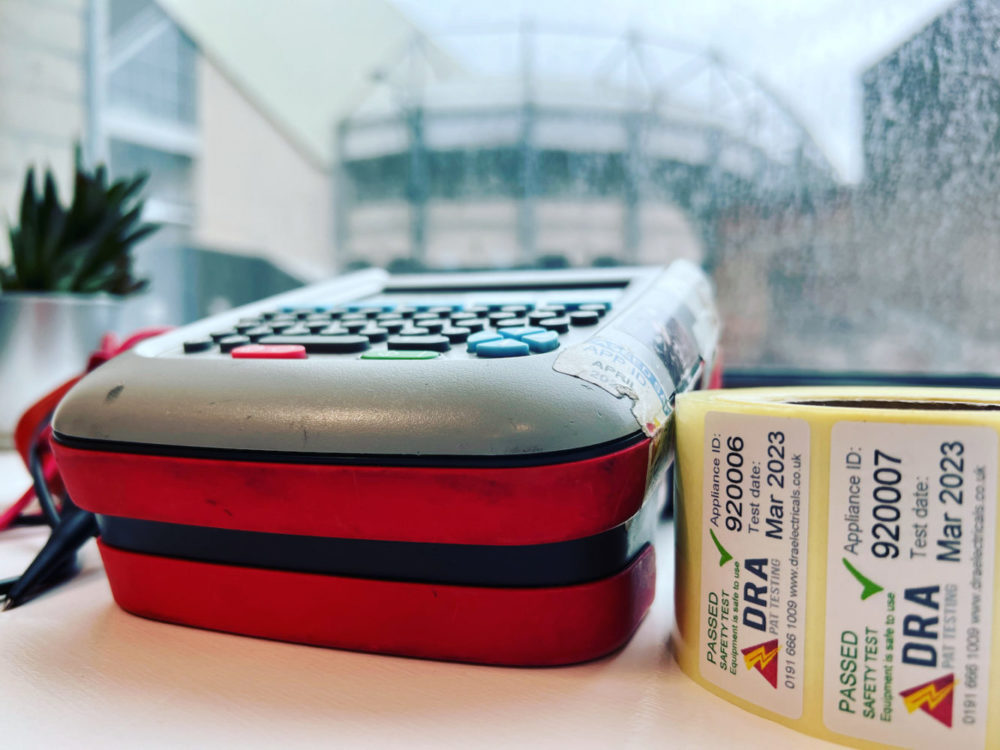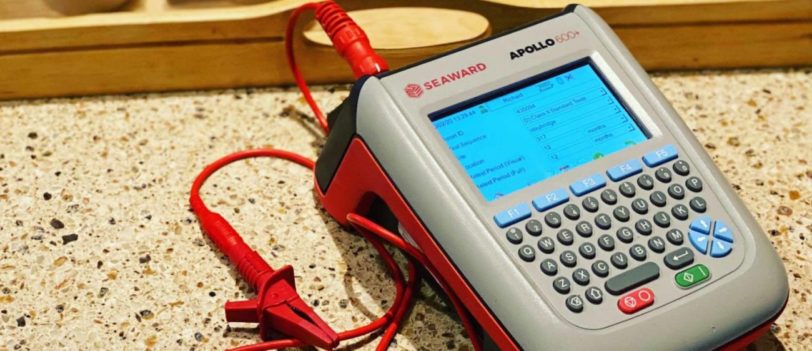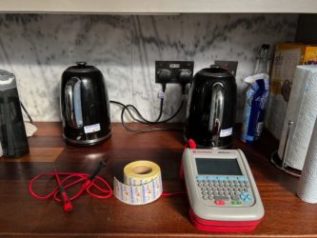Be careful not to overload extension leads
Why the British Plug and Socket is what it is
The British plug and socket is one of the greatest designs to have ever come into this wonderful world we all live in, and despite their being so many options available to help us many of us seem determined to overload our sockets with too many plugs, for no apparent reason at all, except maybe laziness!
The safety features on British sockets are amazing, for example it’s virtually impossible for a child to push something into a socket because the live and neutral holes have safety shutters to stop anything being pushed into them. The only way to release the shutters is to poke something the same size and shape as a plug earth pin into the earth part of the socket; so you’re going to need a really clever child to have an accident.
Another example is the insulation on the pins; the metal parts of the plug pins have to be far enough in to make a connection in the socket, so if they are not far enough in the connection isn’t made so even a partly not plugged in plug, is fairly safe if you accidentally touch it.
We also ask that you only use extension leads for what they are designed for; for example, they’re not intended to be used in kitchens. A kettle and a toaster shouldn’t both be plugged into an extension block.
What is a socket extension lead?
An extension lead, is a length of flexible electrical power cable (flex) with a plug on one end and one or more sockets on the other end, used to help bring the power from the fixed mains socket to an appliance that needs power.
- The extension lead varies in size, depending on how much power it can provide to an appliance / how much power the appliance needs.
- Then to confuse us the “power strip” was invented. This is the block of sockets on the end of an extension lead.
- However, if this block of sockets is not used carefully and correctly it can be easily overloaded – e.g. just because there are 4 sockets it doesn’t mean its safe to use all 4 sockets.
How can I overload an extension lead?
These days it is hard to find a home that doesn’t have at least one socket extension to increase the number of appliances that can be plugged into a wall socket, however even though there is enough space for say, 4 plugs, that doesn’t mean its always safe to plug in 4 plugs.
A socket extension is usually rated at 10, or 13 amps – this means that the maximum rating of all the appliances your plugging in must not exceed this rating. If you do so it will still work, but could cause the plug in the wall socket to overheat, which may in turn start a fire.
- For example; a kettle on its own fills the extension block – nothing else can be plugged in
- A toaster will use about 8 amps
- Now to keep the ladies happy – the hair dryer and straighteners combination will only use about 11 amps, so a 13amp extension will be fine. There’s even space for your phone charger.
- In the office is where a socket extension comes into its own – you can put your PC, with 2 monitors and a printer on a 4-gang extension and only draw around 4-5 amps.
But the office is where a lot of overloads occur, because people think it must be ok to plug in another extension block. The risk comes when filling that one with plugs too, and eventually we get an overload – you should never ever ‘daisy chain’ socket blocks.
How many plugs are safe in one socket multiway bar extension lead?
Socket outlets in an installation are designed with thermal and mechanical protection so they can handle heavier loads; so they can usually resist an overload for a period of time, however a multiway bar extension lead is not made up the same. It’s own thermal and mechanical protection isn’t so efficient and can’t always handle regular overloading, especially from appliances that draw a lot of power like industrial heaters, kettles, and toasters.
If you are using extension leads at work then we recommend you carry out regular inspections and risk assessments to make sure the extension lead isn’t starting to display signs of damage.
The extension lead, like any appliances powered from it is a portable appliance itself and should be inspected and tested as often as the appliance, if not more so, as it may be under even more strain.
If you’re unsure whether you are overloading your sockets the best course of action today is to arrange for us to come in and PAT test, then we can advise you based on our own assessments.
Is it ok to use multiway bar extension leads if we don’t have enough sockets?
The number of appliances we have in our workplaces has increased considerably in the past few years; computers, printers, laptops, tablets, phone chargers. Not to mention coffee machines, kettles, microwaves, fans, heaters, photocopiers, water coolers, etc.
Every one of these appliances has a plug and needs a socket to plug it into.
Whilst new purpose built offices are supposed to have sufficient socket outlets to combat this problem; older buildings are simply not set up for the amount of plugs we have, so the use of multiway extension leads and socket adaptors has become common place.
However, despite seeing extension leads in use in almost every office, under every desk they are not supposed to be intended as a permanent solution – if you need lots of electrical extension leads and use them daily then you need to consider getting some more sockets installed by a good local commercial electrician.
Why we started using extension leads as much as we do
Extension leads were originally intended to provide extra sockets for IT equipment in offices but now they get used for all kinds of electrical appliances so it is no wonder they get overloaded so easily.
Extension leads, blocks, adaptors, call them what you will are widely used; they’re a great device for increasing the number of sockets we have so we can plug in more equipment. You have plenty at home, and probably even more at work, however, you are probably using them incorrectly, potentially very dangerously!
Extension leads (or whatever you call them) were originally created when computers started coming into use more at work, to assist in powering them and their associated device
s, such as printers.
IT equipment doesn’t draw much power, so these leads were created to allow more appliances to be powered from the same socket, than is possible by plugging directly into the socket.
Such leads are generally designed to handle a combined load of less than 12 amps, which at most could be up to 6 low voltage devices; they were not designed to manage the power load required by common household appliances like microwaves, hair driers and fridges.
In offices and similar environments where appliances are all IT equipment, the power requirements are relatively low, and it may not be practical to install enough socket outlets for each appliance.
If this is the case for you, and you’re having to use extension leads for an extended period of time you need to monitor them regularly for any external damage, through regular PAT tests. If this happens then you really need to give serious consideration to installing more sockets.
It often surprises clients when we tell them that they are overloading sockets, because they just don’t realise. Most extension leads have a combined (across all 4 etc. sockets) rating of just 10 or 13amps – the same as one standard 3-pin plug. And it is often the smaller appliances that use the most power.
For example, a fridge hardly uses any power, just 150 watts on average, which is about 10 times less than a microwave, or 20 times less than a kettle! It’s ok to put the fridge on the extension lead, but never a kettle.
Another example is a mobile phone charger – you see adverts all the time about dangerous phone chargers, and some of the cheap imports certainly are, but the real ones that come with the phone from reputable suppliers tend to only draw around 12 watts, which is a staggering 200 times less than your average steam iron!
Here are some examples of how much power an appliance uses:
- Mobile phone charger – 12 watts
- Radio – 40 watts
- Lamp – 60 watts
- Fridge – 150 watts
- Microwave oven – 1550 watts
- Electric Heater – 2000 watts
- Toaster – 2000 watts
- Vacuum cleaner – 2000 watts
- Dishwasher – 2200 watts
- Washing machine – 2220 watts
- Hair drier – 2220 watts
- Tumble drier – 2500 watts
- Iron – 2800 watts
- Kettle – 3000 watts
How many appliances create an overloaded socket?
How many appliances are too many depends on the appliances being plugged in, but best practice is to allow a maximum wattage of no more than 3000 watts to plugged into a socket, although we think that is still too many. More than 3000 watts and you’re risking a fire. To stay safe, we prefer to stay on the side of caution and say no more than 2500, but then still there are some appliances we always recommend against plugging into an extension lead including:
A kettle
A kettle – at 3000 watts that maxes out the extension lead on its own, making using an extension pointless.
We go into kitchens and see toasters and kettles plugged into the same extension lead, and it’s hardly surprising when we scorch marks on the sockets.
This picture is a great example of what can happen if you overload an extension lead in a kitchen.
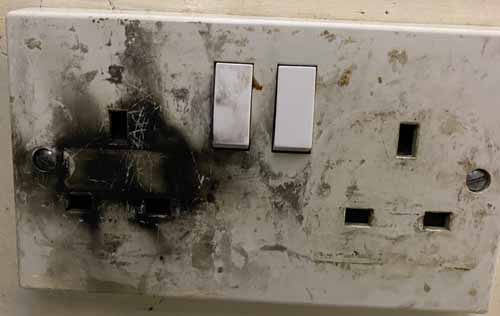
The image above shows what can happen if you overload an extension lead. We see instances where washing machine and dishwashers or tumble driers are plugged in to the same lead; the same can happen there.
Appliances like your fridge, or radio and Lamp are much more suited to sharing an extension lead.
Check out these 15 tips to prevent overloading an extension lead
Is it ok to link more than one extension lead to another?
No, no, never, this is never a good idea. You should never ‘daisy-chain’ extension leads together. The extension lead is not designed to be used attached to another and it will significantly increase the risk of overloading the socket.
We see this so often – extension leads linked to one another under desks in offices, because there is one long desk all powered off the same wall socket. This is not a good idea.
We would recommend in this case either getting more sockets installed or using socket extensions better suited to the job, such as ones with more sockets in, like a 10 gang.
A computer averages only 150 watts, depending on the type, whilst a monitor screen uses only 25 watts, so you can see the difference. The extension lead was originally designed because in the 1980s and 90s as offices got more IT equipment they needed more sockets.
If a 4 gang block can handle 2500 watts, it can easily accommodate a few computers, but with 4 sockets that’s actually not enough, so aim for a 10-socket extension and you can run 8 computers with 2 screens each!
If you want to stay safe follow these 3 simple rules:
- Only plug IT equipment into multi socket extension leads
- Do not link extension leads together
- Book DRA PAT testing to do your next portable appliance testing
If it has 6 sockets it doesn’t mean it’s ok to use all 6
Some of these appliances draw more than 12 amps on their own, so should be plugged directly into a socket.
Just because the extension block has 6 sockets though, doesn’t mean you can plug 6 appliances into it; the block will have a maximum load rating on the back that you must make sure you don’t go over.
Extension blocks should be connected directly into the socket – they should not be connected via another lead, or in a series of leads (aka daisy chained)
Extension blocks are not designed to be a replacement permanent power solutions
Extension blocks shouldn’t be used to power appliances drawing in total more than 12 amps of power
So if you’re using an extension block of any kind to power kitchen appliances; remove it immediately – you don’t need them all switched on at the same time anyway.
If you use such leads at work, in the office, that’s fine as long as it’s only IT equipment using them – unplug the additional leads, and don’t plug in your fans or heaters!
A common misunderstanding is how many appliances can be plugged into an extension lead.
For example, just because the lead has 4 sockets, it doesn’t mean you can plug in 4 appliances. You should only plug in 4 appliances if their combined power draw is no more than the capabilities of the adaptor.
Here are a 2 examples:
Computer + Monitor + printer combined are a perfectly acceptable combination to use on an extension lead, and leave plenty of space to add something else, but be careful what the something else is.
Overloading sockets increases the risk of an accident or fire
To avoid overloading sockets follow this advice from Electrical Safety First:
- Check the current rating of the extension lead before plugging appliances into it. Most are rated at 13 A, but some are rated at only 10 A or less – the rating should be clearly marked on the back or underside of the extension lead. If not, refer to the manufacturer’s instructions
- Never overload an extension lead by plugging in appliances that together will exceed the maximum current rating stated for the extension lead. This could cause the plug in the wall socket to overheat and possibly cause a fire.
- Use our overload calculator (below) to check if you’re exceeding the maximum load
- If you must use an extension lead never plug another extension into it, to prevent over use.
- Use an extension lead (multi-way bar type) rather than a socket adaptor (square shaped) as this puts less strain on the wall socket; some socket adaptors don’t have a fuse, which increases the overload risk.
- Using extension leads increases the risk of overheating.
It’s easy to overload a socket by plugging in too many appliances
It’s easy to plug too many appliances into a socket extension because they make it so easy – the extension lead has 4 sockets, so why shouldn’t I use all 4? Well that is the mistake everyone makes!
At home and at work we all have loads of electrical appliances, and year on year we add more and more to our collection, meaning we need more and more sockets to plug them in to. Over the years you have also likely acquired a collection of extension leads too and you’ll likely use at least one, if not a bunch of them in sync to try to create enough space to plug everything in.
However, just because your socket extension has 4 sockets it doesn’t mean it is safe to plug in 4 appliances; some appliances require so much power that they can draw more power than even the extension lead can handle, so grouped together with 3 other appliances we have a real fire risk on our hands.
An example of Overloading Sockets
In this example of overloading, these extension leads are powering 19 AC adaptors, which as we know don’t draw much power. However, there is a bigger picture to consider.
Here we have 19 AC adaptors and 5 extension leads all attached to one extension lead, which is about 10 metres long to the nearest double socket, which has another extension lead on, about the same length which feeds 5 more extension leads with computers, cash registers and other appliances on.
That is a serious overload for the double socket on the wall.
